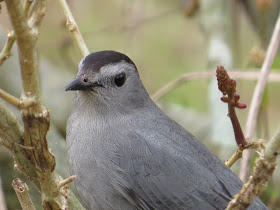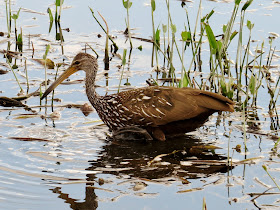Wednesday, February 3rd
Day 3
 |
| Lifeguard Station at Ponce Inlet |
Day three, on this birding vacation, was supposed to be spent at Florida Caverns State Park near Marianna, plus searching the barren cotton and peanut fields for horned larks and such. But thunderstorms are expected, so we're skipping this day's scheduled venues and heading over to the Atlantic Coast a day early.
 |
| A young Great Black-back Gull at Ponce |
So we left Tallahassee for the long drive toward Ormond Beach for some sea watching. At a location at Gamble Roger State Park we checked the skies for sea birds and Bob did point out that the winds weren't good for us.
Was able to spot a few Northern Gannets and Brown Pelicans off shore. I've been lucky in the past to witness hundreds of gannets as well passing jaegers and sea ducks at this location. On the beach were a few gulls and terns including Herring, Ring-billed and Laughing Gulls, plus Royal, Sandwich and Forster's Terns and Black Skimmers.
After this short stop at the beach, we moved onto Ponce Point Lighthouse Park. Most winters this location is one of two or three venues in Florida to find Purple Sandpipers. Today the the winds a blowing hard and the surf is crashing. The are actually people trying to surf.
 |
| Purple Sandpiper |
 |
| Ruddy Turnstone |
 |
| Ponce Lighthouse |
We were able to easily locate and photograph the Purple Sandpiper, as well as a few other shore birds and gulls. Resident Gopher Tortoises also gave us a show.
 |
| This Tortoise was very aggressive with another tortoise and did attach it |
Finally, we moved onto Merritt Island National Wildlife Refuge to see if any waterfowl could be seen. But just as we saw with the Canada Geese in Tallahassee and the ponds at St Marks, the waters were bare of ducks. We estimated a count of 5000 American Coots along the Black Point Wildlife Drive and the along the Peacock Pocket Road. As for ducks we only counted twenty-four Blue-winged Teal, three Shovelers, five Lesser Scaups and a pair of Mottled Ducks. A review of e-Bird records shows that the waterfowl usually remain well into March and later. However its apparent that they have left early to return North. No doubt due to the high water levels here and a very mild winter.
 |
| Great Blue Heron |
 |
| Horned Grebe |
 |
| Wood Stork |
Other bird like observed included lots of the expected waders including over twenty Rosette Spoonbills and Reddish Egrets, But not many shorebirds - Dunlin, Sanderlings, Least Sandpipers and Greater and Lesser Yellowlegs. Didn't see any American Avocets. Other birds included Common Gallinule, Caspian, Royal and Forster's Terns, Ringed-billed Gulls, Pied-billed and Horned Grebes, a Wild Turkey, Ospreys, Northern Harrier and Bald Eagle
Our exit from Merritt Island ended the birding vacation. We ended up cutting two full days out of trip, mostly due to the weather. Just the same we had about 125 species and three Lifers for me. All Good.
Trip Count ( 125)
Black-bellied Whistling Duck, Wood Duck, Mottled
duck, Blue-winged Teal, Northern Shoveler, Redhead, Ring-necked Duck, Lesser
Scaup, Bufflehead, Red-breasted Merganser, Wild Turkey, Common Loon,
Pied-billed Grebe, Horned Grebe, Wood Stork, Northern Gannet, Double-crested
Cormorant, Anhinga, American White Pelican, Brown Pelican, Sandhill Crane, American
Bittern, Great Blue Heron, Great Egret, Snowy Egret, Little Blue Heron,
Tricolored Heron, Reddish Egret, Cattle Egret, Black-crowned Night-heron, White
Ibis, Glossy Ibis, Roseate Spoonbill, Black Vulture, Turkey Vulture, Osprey,
Northern Harrier, Bald eagle, Red-shouldered Hawk, Clapper Rail, Sora, Purple
Gallinule, Common Gallinule, American Coot, Limpkin, Black-bellied Plover,
Semipalmated Plover, Killdeer, Greater Yellowlegs, Willet, Lesser Willet, Ruddy
Turnstone, Sanderling, Dunlin, Purple Sandpiper, Least sandpiper, Western Sandpiper, Short-billed Dowitcher, Wilson's Snipe, Laughing Gull, Ring-billed
Gull, Herring Gull, Great Black-backed Gull, Caspian Tern, Forster's Tern, Sandwich
Tern, Black Skimmer, Rock Pigeon, Eurasian Collared-Dove, Common Ground-Dove,
Mourning Dove, Great Horned Owl, Vaux's Swift, Ruby-throated Hummingbird, Black-chinned
Hummingbird, Rufous Hummingbird. Calliope Hummingbird, Belted Kingfisher,
Red-bellied Woodpecker, Downy Woodpecker, American Kestrel, Eastern Phoebe, Vermilion Flycatcher,
Loggerhead Shrike, White-eyed Vireo, Blue Jay, American crow, Fish Crow, Tree
Swallow, Carolina Chickadee, Tufted Titmouse, White-breasted Nuthatch, House
Wren, Sedge Wren, Marsh Wren, Carolina Wren, Blue-gray Gnatcatcher, Eastern
Bluebird, Hermit Thrush, American Robin, Northern Mockingbird, Eurasian
Starling, American Pipit, Cedar Waxwing, Orange-crowned Warbler, Common
Yellowthroat, Palm Warbler, Pine Warbler, Yellow-rumped Warbler, Chipping
Sparrow, Savannah Sparrow, Song Sparrow, Swamp Sparrow, Eastern Towhee,
Northern Cardinal, Red-winged Blackbird, Eastern Meadowlark, Boat-tailed
Grackle, Common Grackle, Baltimore Oriole, House Finch, Pine Siskin, American
Goldfinch and House Sparrow



























































